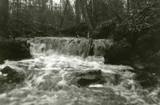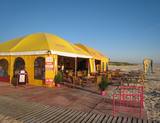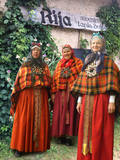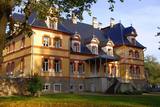| Nr | Name | Beschreibung |
|---|---|---|
|
Hier gibt es einige “canyon-ähnliche” Schluchten zwischen den Dolomitablagerungen. Man findet interessante Aufschlüsse und kleine Wasserfälle im kleinen Flussbett.
|
||
|
Der Pavillon – Rotonda der Liebesinsel –
wurde 1928 im klassizistischen Stil gebaut.
Seinerzeit gab es hier einen Bootsanlegeplatz.
Bis jetzt wird geplant den runtergekommenen
und gefährlichen Pavillon zu erneuern.
|
||
|
Die Schänke befindet sich im Zentrum von Jelgava: An der Brücke über den Fluss Driksa, die von der neu eingerichteten Uferpromenade eingeschlossen ist. Für die Innenausstattung sind Elemente aus Holz verwendet worden. Hier werden regelmäßig Musikabende veranstaltet. Lettische Küche: Kalte Suppe, gebratenes Flunder- oder Kabeljaufilet, Bauernfrühstück, Kartoffelpfannkuchen, dünne Pfannkuchen. |
||
|
Beach cafe at the end of Jūrmalas Street, by the beach, in Liepāja. Live music in the Wind Garden on Wednesdays, Fridays and Saturdays. Offers breakfast, lunch, dinner, coffee and drinks. |
||
|
Ideja par "DA'ZIEPE" radās iedvesmojoties no Amatas novada dabas un idejas par pilnvērtīgu pieejamo resursu izmantošanu. Ziepes tiek gatavotas no liellopu vai briežu taukiem, augu eļļām un ziepju zālēm, kā arī papildinātas ar dažādām ēteriskajām eļļām un dabīgajiem aromātiem. |
||
|
Meklējams Matsalu līča dienvidu krastā pie Kēmu ostas (Keemu sadam). Blakus sešus metrus augstajam metāla – koka tornim uzcelts neliels apmeklētāju centrs. Tāpat kā no Haeskas torņa, arī no šī paveras viena no izcilākajām Matsalu līča un tā piekrastes ainavām. Laba putnu vērošanas vieta migrāciju laikā. |
||
|
The memorial site with a 1936 monument produced by the sculptor Kārlis Zāle is located in Smārde near the Smārde-Tukums road. It commemorates 38 soldiers who fell during World War I. Between 1915 and 1917, the front line was near Smārde. Many men were killed, and they were buried at the local swamp. It was only after the war that they were reburied in Smārde, Kūdra, Ķemeri, and Sloka. |
||
|
In der alten Getreidedarre des Landgutes von Alsunga befindet sich ein Souvenirgeschäft, in dem man Souvenirs und im Haushalt nützliche Dinge kaufen kann, die in dem Kreis von Suiti hergestellt sind: Tücher (die Kleidung von Suiti zeichnet sich durch lebhafte Farben aus), Handschuhe, Socken, Geschirr, Tees u.a. Hier werden kreative Werkstätte organisiert. |
||
|
Das Landgutsensemble in Milzkalne am Ufer des Flüsschens Slocene begann sich im 15. Jahrhundert zu bilden als einen geschlossenen Komplex fränkischen Typs für die Wirtschaftsbedürfnisse des Ordens und ist heutzutage ein einzelnes erhaltenes Beispiel eines befestigten Landguts solchen Typs (als ein Versteck für Gutsbesitzer im Angriffsfall) in Lettland. Am Ende des 17. Jahrhunderts wurden Tortürme mit den herrschaftlichen Flügeln, aber in den 18 – 19 Jahrhunderten – auch die Wirtschaftsgebäude errichtet. Von der ursprünglichen Bebauung ist eine Mauer mit den Schießöffnungen erhalten geblieben. In einem der Flügel des Komplexes wurde das Straßenbaumuseum Lettlands eingerichtet. In einem Hauptgebäude des Landguts befindet sich ein Hotel, hier werden Exkursionen und Verkostungen von Landerzeugnissen angeboten. |
||
|
Ein Abschnitt der Schmalspurbahnlinie mit Spurbreite 750 mm, der Alūksne un Gulbene verbindet ist in Teil der ehemaligen Eisenbahnlinie Stukmaņi – Valka. Zurzeit ist es die einzige Schmalspurbahn mit ständigem Personenverkehr in Lettland, die noch im Betrieb ist. Die Bānītis fährt jeden Tag. Ein im Südteil der Stadt Alūksne gebautes Stationsgebäude wurde 1903 eröffnet. Die Linie ist 33 km lang und hat 10 Stationen und Haltepunkte. Die Fahrt mit der Bānītis dauert ~ eineinhalb Stunden. Populär ist ein jährliches Fest der Schmalspurbahn Alūksne – Gulbene, zu dem viele Gäste kommen. |
||
|
Besucher können eine Töpferwerkstatt kennenlernen, dem Meister bei seiner Arbeit zuschauen, versuchen selbst etwas zu formen, Tonprodukte, unter anderem auch Gartendekors aus Keramik, erwerben und einen schönen Garten bewundern. |
||
|
This barrow is on the western side of the Dunduri meadows and was built on the parking lot of the former collective farm. From the second level of the tower, you will have an excellent view of the meadows all the way to the Džukste River and the Kauguri canal. There are livestock accustomed to life in the wild, although they will sometimes be quite distant. This is a bird-watching location from the springtime until the second half of the summer. |
||
|
Am Ufer des Sees Mooste befindet sich der Gutshof Mooste. Neben dem schönen Hauptgebäude liegt als Perle des Gutshofs Mooste einer der großzügigsten Komplexe an Nebengebäuden im historizistischen Stil in Estland. Der englische Park umgibt das Hauptgebäude, wo eine Schule untergebracht ist. In der renovierten Holzwerkstatt ist heute das Gästehaus, im ehemaligen Pferdestall befindet sich das Haus der Restauratoren, im Gutsverwaltershaus das Zentrum für Kunst und Sozialpraktikum und der ehemalige Viehstall dient heute als Konzertsaal. |
||
|
Dodieties ekskursijā, lai gūtu ieskatu lauku profesijā un dzīvesveidā, kā arī iegūtu jaunus iespaidus un labu atpūtu visai klasei. Ekskursijas laikā apmeklējiet kokapstrādes darbnīcu, kurā ražo visu saimniecībā nepieciešamo – solus, galdus, pakaramos, virtuves piederumus, pirts baļļas, mucas, lieliskus suvenīrus no koka u.c. Pēc tam apmeklējiet zemnieku saimniecību, kura ir viena no lielākajām un modernākajām zemnieku saimniecībām Zemgalē. Izbaudiet pusdienu pikniku Tērvetes dabas parkā. Ekskursijas noslēgumā dodieties uz maizes ceptuvi, lai izzinātu maizes cepšanas arodu, degustētu un iegādātos maiznīcas izstrādājumus. |
||
|
Die Gastgeberin im russischen Bauernhof (Vene talu) bereitet köstliche russische Nationalgerichte nach den Rezepten ihrer Großmutter zu. Die Gäste werden mit Sitten vertraut gemacht und es werden reichhaltige Verkostungen angeboten. Es gibt auch einen Teesalon, Meisterklassen für russische Küche. |
||
|
On 14 June 1991, this sign sculpted by Zezostrs Ķēde in memory of the repressions of 1941 and 1949 was unveiled in the garden of Pēterupe Church. |
||
|
Tūrisma gide Ineta Jansone piedāvā ekskursijas grupām pa Raganu purvu. Izveidota taka uz sēra dīķiem (koka celiņi 800 m garumā). Ekskursijas laikā Jūs uzzināsiet par augstā tipa purvu un unikālu biotopu – sēra avotu izplūdes vietu Ķemeru Nacionālā parka teritorijā. Šeit sastopami savdabīgi purva ezeriņi, piesātināti ar sēra baktēriju radītām nogulsnēm. Ezeriņu krastos sastopami īpašu sugu augi. Sēra dīķu apkaimē var sajust gaisā sērūdeņraža smaržu. |
||
|
This is a farm which produces beef. You can take a tour, during which you can learn about, taste and purchase untraditional herbs and exotic tea plants. |
||
|
The owner of the venue makes homemade wine on the basis of traditions that have been handed down from generation to generation. You can taste four different wines along with snacks and engage in philosophical discussions about winemaking recipes. You can also buy the wines. |
||
|
Die ehemalige Stadt Memel. Die einzige Hafenstadt Litauens mit einer Altstadt. |
||
























